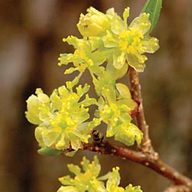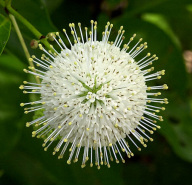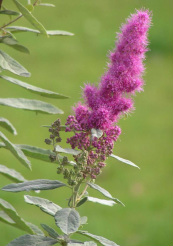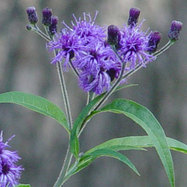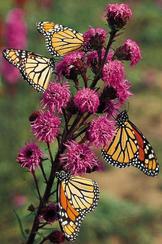The FACTS about butterfly bush
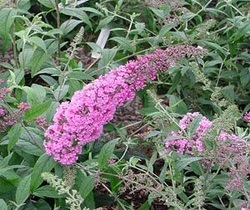
Butterfly bush (Buddleja davidii) is commonly touted as a “must have” for attracting butterflies. While there is no denying they draw tons of butterflies with their showy, nectar rich blooms - they also harm butterflies by posing a threat to the larger ecosystem.
What’s the problem?
Butterfly bush is a non-native invasive species from Asia. Because it spreads easily, and has no natural predators in our region, it outcompetes native plants greatly reducing the diversity of food and shelter for sustaining wildlife.
The second problem with butterfly bush is that, while it draws butterflies with its nectar, it does not supply butterfly larvae with food. This means the bush lures in butterflies, distracting them with promises of sweet nectar - but meanwhile these butterflies will have to expend time and energy finding another place to lay their eggs. If an acceptable host plant is not nearby, the adult butterfly will not be able to produce the next generation of offspring.
What about cultivars bred to be “non-invasive” are those ok?
Several varieties are now appearing on the market being advertised as non-invasive. Unfortunately, when these cultivars break sterility and cross pollinate with invasive forms of butterfly bush, they take on the invasive characteristics. An example of this can be found in the callery pear (aka bradford pear), which was brought to the US as a “sterile” non-invasive landscaping tree. It has since broken sterility and can now be found spreading throughout woodlands and other habitats.
So what can I plant instead?
There are many alternatives that do a much better job supporting butterflies and the larger food web. For example, an oak tree supports over 500 species of Lepidoptera (butterflies and moths) while providing shelter for a variety of other wildlife. If you’re looking for a shrub or flowering plant for the home landscape however, here are some suggestions with similar characteristics to Butterfly Bush.
What’s the problem?
Butterfly bush is a non-native invasive species from Asia. Because it spreads easily, and has no natural predators in our region, it outcompetes native plants greatly reducing the diversity of food and shelter for sustaining wildlife.
The second problem with butterfly bush is that, while it draws butterflies with its nectar, it does not supply butterfly larvae with food. This means the bush lures in butterflies, distracting them with promises of sweet nectar - but meanwhile these butterflies will have to expend time and energy finding another place to lay their eggs. If an acceptable host plant is not nearby, the adult butterfly will not be able to produce the next generation of offspring.
What about cultivars bred to be “non-invasive” are those ok?
Several varieties are now appearing on the market being advertised as non-invasive. Unfortunately, when these cultivars break sterility and cross pollinate with invasive forms of butterfly bush, they take on the invasive characteristics. An example of this can be found in the callery pear (aka bradford pear), which was brought to the US as a “sterile” non-invasive landscaping tree. It has since broken sterility and can now be found spreading throughout woodlands and other habitats.
So what can I plant instead?
There are many alternatives that do a much better job supporting butterflies and the larger food web. For example, an oak tree supports over 500 species of Lepidoptera (butterflies and moths) while providing shelter for a variety of other wildlife. If you’re looking for a shrub or flowering plant for the home landscape however, here are some suggestions with similar characteristics to Butterfly Bush.
Native alternatives to butterfly bush
SpicebushLindera benzoin
Grows from 6’ - 12’ in full sun to full shade. Spicebush is a three season beauty featuring showy yellow blooms in spring, followed by attractive green foliage and bright red berries that persist into winter. Spicebush is a host plant for the Spicebush Swallowtail, the berries are enjoyed by birds, and the early spring blooms provide a much needed food source for native bees. |
button bushCephalanthus occidentalis
Grows from 6’ to 10’. Though commonly found in swamps and along stream banks, Button Bush grows in a wide range of soil and moisture conditions once established. Like Butterfly Bush, Button Bush can be heavily pruned to maintain size and shape. The real treat however is in the sputnik-like showy flowers that bloom in big round bursts and once spent leave behind an interesting button-like seedhead. Butterflies adore the sweet flowers and flock to button bush in great numbers. |
Native spireaSpirea tomentosa, Spirea alba
Though more difficult to find than non-native Japanese spirea species (S. japonica), our native spireas tolerate a wide range of conditions from dry lake beds to wet meadows and along roadsides. Forming large dense mounds from 3’ to 6’ tall, the rose-purple flower spikes of S. tomentosa, or white blooms of S. alba are stunning when in bloom and support a large number of native pollinators. Both feature golden fall foliage, and the dried flower spikes provide winter interest and shelter. |
new york ironweedVernonia noveboracensis
A tall clump forming perennial which grows from 5’ to 8’ tall, NY Ironweed features clusters of deep reddish-purple flowers atop slender stems. It is not uncommon to see a variety of butterflies jockeying for position atop these flowers, and they are especially attractive to monarch butterflies filling up before their migration begins. |
blazing starLiatris spp.
There are a variety of species of Blazing Star, all feature grass-like foliage with tall spikes of flowers ranging from red to purple. These flower spikes are so showy they are often used by florists for cut flower arrangements. They are especially attractive to butterflies who are frequent visitors, as are hummingbirds and native bees. Meadow blazing star, Liatris ligulistylis, also known as Dense blazing star, features a compact habit growing only 1’ to 3’ with dense tufted flower spikes atop grass-like foliage, making it an attractive addition to perennial borders in the home landscape. |
Source: Douglas Tallamy, Bringing Nature Home (2009).

